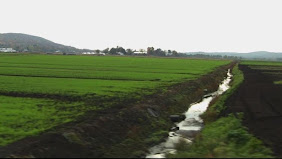In May I was lucky enough to spend some time on a farm in the Black Dirt Region in Orange County, New York. Only about 50 miles northwest of New York City in the lower Hudson Valley, this area is characterized by beautiful estates, orchards and vineyards, charming Colonial-era villages, picturesque farms and fields of deep black dirt. All of these can be found elsewhere, except for that dirt.
Before I go any further, I want you to imagine the softest and silkiest potting soil that you’ve ever seen. That is what New York’s black dirt is like – in fact, it’s more like powder than soil. This special soil was formed some 12,000 years ago after a glacier receded, leaving a bog in place of the ancient lakebed. After that, repeated flooding in the area augmented the development of the swamp-land and added to the soil profile. The deep layers of decayed plant matter in the bog created a soil rich in nutrients (notably sulfur) that is anywhere from 3 to 30 feet deep (some claim as much as 300 feet). This region of New York contains 26,000 acres of Black Dirt, making it the largest concentration of farmable soil of this sort in the US. The only other place you’ll find as much is deep in the Everglades and inaccessible to farming.
Onions, onions, onions – the cultivation, tradition, and business of onions is always swirling around the Drowned Lands. The predominant onions of this area are the tennis ball-sized yellow onions with papery skin that we are all familiar with. The sulfur in the soil increases the sugar content in onions and gives it a delicious strong, rich onion taste that turns exceptional when caramelized. It’s also hard to beat in a soup (here's a local recipe to try).
It's not just onions that grow well in black dirt, of course. All the root vegetables (beets, carrots, garlic, radishes) love to grow down into that rich soil. Lettuce of all types, kale, kohlrabi and cabbages all thrive as well. In the last 25 years or so, growing sod has become a reliable venture and, even more recently, hemp has proven itself in the area. As you can see, it might be challenging to find something that does not grow well in black dirt.
Plants are not the only things that farmers are pulling out of the black dirt. As a testament to what was once a robust prehistorical world in the lower Hudson Valley, there have been an abundance of fossils found. According to this article, there are actually three distinct geological layers in the area: the deepest level is clay, the middle level is a mix of peat and clay and the black dirt makes up the top layer. Peat bogs are famous for preserving artifacts; in some parts of the world, they may be “bog bodies”, but in this part of New York the peat/clay layer of the black dirt has been holding onto prehistoric fauna. Mastodon finds are arguably the most impressive; not just for their size (the largest animals that roamed the area) but due to their rarity. More mastodon remains have been found in New York State than any other place on Earth and more have been found in Orange County than any other part of the state (more on that here). Mastodons are not the only ancient creatures coming to light, stag-moose, giant beavers, peccaries, reindeer and ground sloths have also been found. Many of these fossils are discovered as farmers do maintenance on their drainage ditches after the growing season, but they are under no obligation to turn them over to authorities so there very well may be other types of animal fossils out there that the public has not seen.
The Black Dirt Region truly has something for everybody. If you are an American History buff, you can drink and eat in establishments that date to the American Revolution. If you are a flora and fauna type person, the countryside and mountains are simply gorgeous and filled with wildlife (I saw a big ole black bear lumbering along). If you enjoy a good adult beverage, there are many first-class vineyards, cideries and breweries to visit. If you are a foodie, the options are nearly limitless. And, of course, if you are a person who loves to grow things, the black dirt is a thing of beauty and wonder.














No comments:
Post a Comment